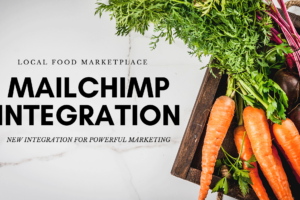
The Troy Waterfront Farmers Market in the summer, pre-COVID-19.
The Troy Waterfront Farmers Market has provided local food to the Troy, NY area for the last twenty years. They’ve grown from a 10-15 vendor operation to a 110-vendor, multi-street, year-long market – but when COVID-19 hit, they had to figure out how to continue as an essential business, despite a shut-down order from their county health department. We spoke to Steve Ridler to learn more.
LFM: Hi Steve! Thank you so much for agreeing to be interviewed – I know you must be very busy these days!
Steve: Yes indeed – very busy.
LFM: To start things off, could you give us a little background on your market?
Steve: Sure. The Troy Waterfront Farmers Market turned twenty last year – it started out in a small waterfront parking lot – hence the name. We had between 10 and 20 vendors, and we had a regional grant to help us get started. We started off like most markets at the time: fruits, vegetables, and a little bit of prepared food. Then over time, the market got bigger and bigger, and then we moved to a waterfront park and got even bigger. Now we’ve expanded from 10-20 vendors to 110 vendors, and we are located (in the summer) on a city street extending three to four blocks and around a square, with a hub of prepared food vendors in the middle. [Pre COVID-19] any given Saturday we were getting between 12,000 and 18,000 people in a five hour period. It’s a big market. We’re also a 52-wks-a-year market, so in the winter we move indoors and we keep about the same number of vendors.
We are a 501c(6) organization, so we operate on behalf of the market members. Our board is made up of vendors and community liaisons. That board oversees the operation of the market which is staffed by a market manager, and up until recently one market assistant.
I’m actually Liz’s replacement! [Editor’s note: Liz Hammond has been the Sales and Marketing Coordinator for LFM for two years, and previously she was the Operations Manager for the Troy Waterfront FM.] Liz left the market, and I said “Oh, you know, I’m just retiring from my State job, so I’ll help you guys out.” And now here I am! And now, obviously, we’re dealing with the COVID-19 situation.
LFM: Walk me through your experience with COVID-19 – what happened, when, and what changed for your market?
Steve: We changed very abruptly. We saw it coming, but we didn’t know quite what it was going to do. We knew we would attract the attention of the regulators, and say “Hey, we’re a pretty big market with lots of people coming in – what’s going to happen?”
Although our governor established that farmers markets were essential (and could remain open) our county health department did not want us open because we were too big of a regional attraction. We don’t just pull people from Troy – we pull people from all over the capital district. At that point there were a limited number of cases in the towns around us so they didn’t want people moving from one town to another town. So we closed down because social distancing would not be possible during the height of infections in our area. So we thought that was time to revisit this long-standing idea about creating an online platform.
LFM: What brought you to LFM?
Steve: We knew about LFM because of Liz, but we’d looked at it before and had been thinking about going in that direction [before COVID-19 hit.]
We were looking for a system that offered aggregation. We were also looking for something that was already a success and that worked. We wanted robustness, we wanted a sound platform. Some of the platforms out there are more suited to individual farms. But we didn’t just need an online store, we needed more.
LFM: Was there a particular feature of the LFM platform that you found essential?
Steve: It was the ability to showcase all our producers on one site. [We needed] the ability to aggregate orders within the system and create a hub. It was also the pick lists, packing list options, and the ability for a customer to sign on and see [all our producers], from one shopping cart. We also needed the ability to offer distribution more than one day a week, plus we were thinking about doing deliveries. Really, we were attracted to the robustness of the options that we got with LFM.
LFM: Going forward, what role do you think LFM plays with your market?
Steve: We’re also looking at the future, and thinking that we can become a hub for restaurants. There was a lot of flexibility among the packages and options that LFM offered that we could customize and choose what one made sense now and then expand later on. So that’s what we were looking for, and why we chose LFM.
And, we’ve got lots of customers who don’t actually want to come to a farmers market now. The market that we’ve reopened is a much reduced size; we’re at 600-700 customers on a Saturday, instead of 20,000. That leaves a lot of people that need to get their food from somewhere, and the online market continues. We’re adding vendors every week from our pool of vendors – we started with 30 and now were at about 45. So there’s a lot of continuing interest from vendors about being in it.
LFM: How has your customer base responded?
Steve: We had lots of people signing up and lots of orders being placed early on. We are at 3,500+ registered users right now… In our first week. we received 225 orders! The lines went down the street and people just kept coming. Now, our capacity is between 300-400 orders a day. I know we can now handle a possible COVID resurge in the fall or any other market change, because we’ve created something that works.
LFM: How has your vendor base responded to using the LFM platform?
Steve: A lot of them said “Hey, this is another opportunity for us to sell, let’s jump right in!” They like it, they’re all very impressed. They like the ability to get a pick list with details, with everything that they need. We’ve managed to figure out the right drop off times for everybody. They’ve responded very well.
Something we found very helpful was this: [before we onboarded producers], our staff created the producer profiles and added the detail from each vendor. We created our own categories and subcategories and then sent the site to the producers with a lot of information already in place. They were given the [producer] manual in advance, but we had already done all the heavy lifting. All they really had to do was set their price, select their products from the list we had created, modify them accordingly, and then put in their inventory. It saved so much time for them.
LFM: What would you say to a market manager who is just starting this process?
Steve: I would say: step back and think about what you want to do and how you want to do it.
About halfway through planning, we had an epiphany; we thought “Oh my, we’ve created a monster! There’s going to be all these vendors with all this produce that we have to aggregate into all these bags for all these customers… how are we going to do that?” We realized that we needed some infrastructure and space to support the aggregation process.
Then, on the local news that night they featured a local restaurant wholesaler that was laying off their drives and emptying their cold storage unit. So, I called him the next morning and he agreed that we could take over one of his cold storage spaces and use it as our aggregation hub. So now we had refrigeration, a freezer, a loading space, and a massive parking lot. It’s a great partnership and hopefully we’ll be able to continue it.
But if you don’t have that facility, how do you aggregate? You have to think about the scale, how many customers you’ll serve and how much product you’re going to move in a day. You just can’t have fresh food if you don’t have the storage capacity or the storage facilities.
So everyone should think about how they’re gonna do this. I did a lot of research and [and I found that] LFM is flexible enough to meet the needs of a bunch of different models we might need.



